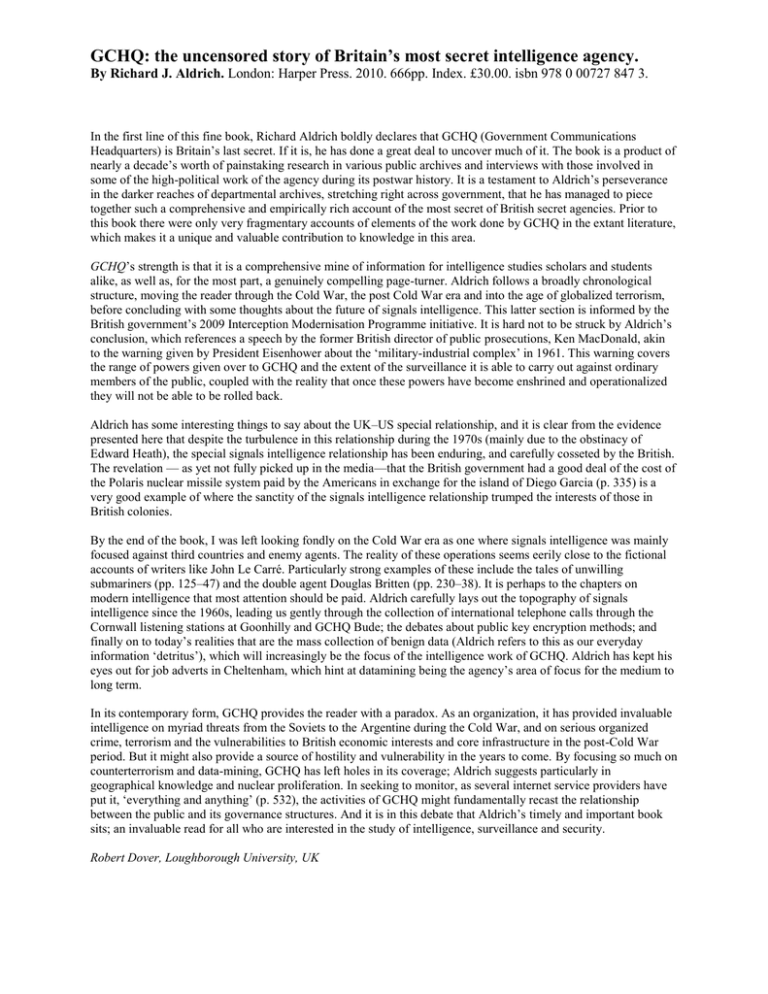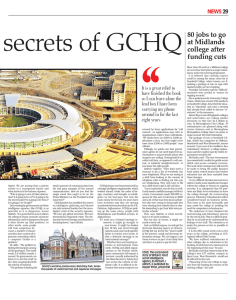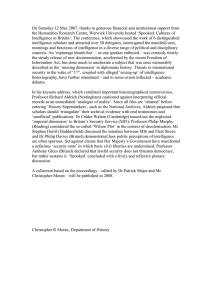GCHQ: the uncensored story of Britain’s most secret intelligence agency.
advertisement

GCHQ: the uncensored story of Britain’s most secret intelligence agency. By Richard J. Aldrich. London: Harper Press. 2010. 666pp. Index. £30.00. isbn 978 0 00727 847 3. In the first line of this fine book, Richard Aldrich boldly declares that GCHQ (Government Communications Headquarters) is Britain’s last secret. If it is, he has done a great deal to uncover much of it. The book is a product of nearly a decade’s worth of painstaking research in various public archives and interviews with those involved in some of the high-political work of the agency during its postwar history. It is a testament to Aldrich’s perseverance in the darker reaches of departmental archives, stretching right across government, that he has managed to piece together such a comprehensive and empirically rich account of the most secret of British secret agencies. Prior to this book there were only very fragmentary accounts of elements of the work done by GCHQ in the extant literature, which makes it a unique and valuable contribution to knowledge in this area. GCHQ’s strength is that it is a comprehensive mine of information for intelligence studies scholars and students alike, as well as, for the most part, a genuinely compelling page-turner. Aldrich follows a broadly chronological structure, moving the reader through the Cold War, the post Cold War era and into the age of globalized terrorism, before concluding with some thoughts about the future of signals intelligence. This latter section is informed by the British government’s 2009 Interception Modernisation Programme initiative. It is hard not to be struck by Aldrich’s conclusion, which references a speech by the former British director of public prosecutions, Ken MacDonald, akin to the warning given by President Eisenhower about the ‘military-industrial complex’ in 1961. This warning covers the range of powers given over to GCHQ and the extent of the surveillance it is able to carry out against ordinary members of the public, coupled with the reality that once these powers have become enshrined and operationalized they will not be able to be rolled back. Aldrich has some interesting things to say about the UK–US special relationship, and it is clear from the evidence presented here that despite the turbulence in this relationship during the 1970s (mainly due to the obstinacy of Edward Heath), the special signals intelligence relationship has been enduring, and carefully cosseted by the British. The revelation — as yet not fully picked up in the media—that the British government had a good deal of the cost of the Polaris nuclear missile system paid by the Americans in exchange for the island of Diego Garcia (p. 335) is a very good example of where the sanctity of the signals intelligence relationship trumped the interests of those in British colonies. By the end of the book, I was left looking fondly on the Cold War era as one where signals intelligence was mainly focused against third countries and enemy agents. The reality of these operations seems eerily close to the fictional accounts of writers like John Le Carré. Particularly strong examples of these include the tales of unwilling submariners (pp. 125–47) and the double agent Douglas Britten (pp. 230–38). It is perhaps to the chapters on modern intelligence that most attention should be paid. Aldrich carefully lays out the topography of signals intelligence since the 1960s, leading us gently through the collection of international telephone calls through the Cornwall listening stations at Goonhilly and GCHQ Bude; the debates about public key encryption methods; and finally on to today’s realities that are the mass collection of benign data (Aldrich refers to this as our everyday information ‘detritus’), which will increasingly be the focus of the intelligence work of GCHQ. Aldrich has kept his eyes out for job adverts in Cheltenham, which hint at datamining being the agency’s area of focus for the medium to long term. In its contemporary form, GCHQ provides the reader with a paradox. As an organization, it has provided invaluable intelligence on myriad threats from the Soviets to the Argentine during the Cold War, and on serious organized crime, terrorism and the vulnerabilities to British economic interests and core infrastructure in the post-Cold War period. But it might also provide a source of hostility and vulnerability in the years to come. By focusing so much on counterterrorism and data-mining, GCHQ has left holes in its coverage; Aldrich suggests particularly in geographical knowledge and nuclear proliferation. In seeking to monitor, as several internet service providers have put it, ‘everything and anything’ (p. 532), the activities of GCHQ might fundamentally recast the relationship between the public and its governance structures. And it is in this debate that Aldrich’s timely and important book sits; an invaluable read for all who are interested in the study of intelligence, surveillance and security. Robert Dover, Loughborough University, UK




